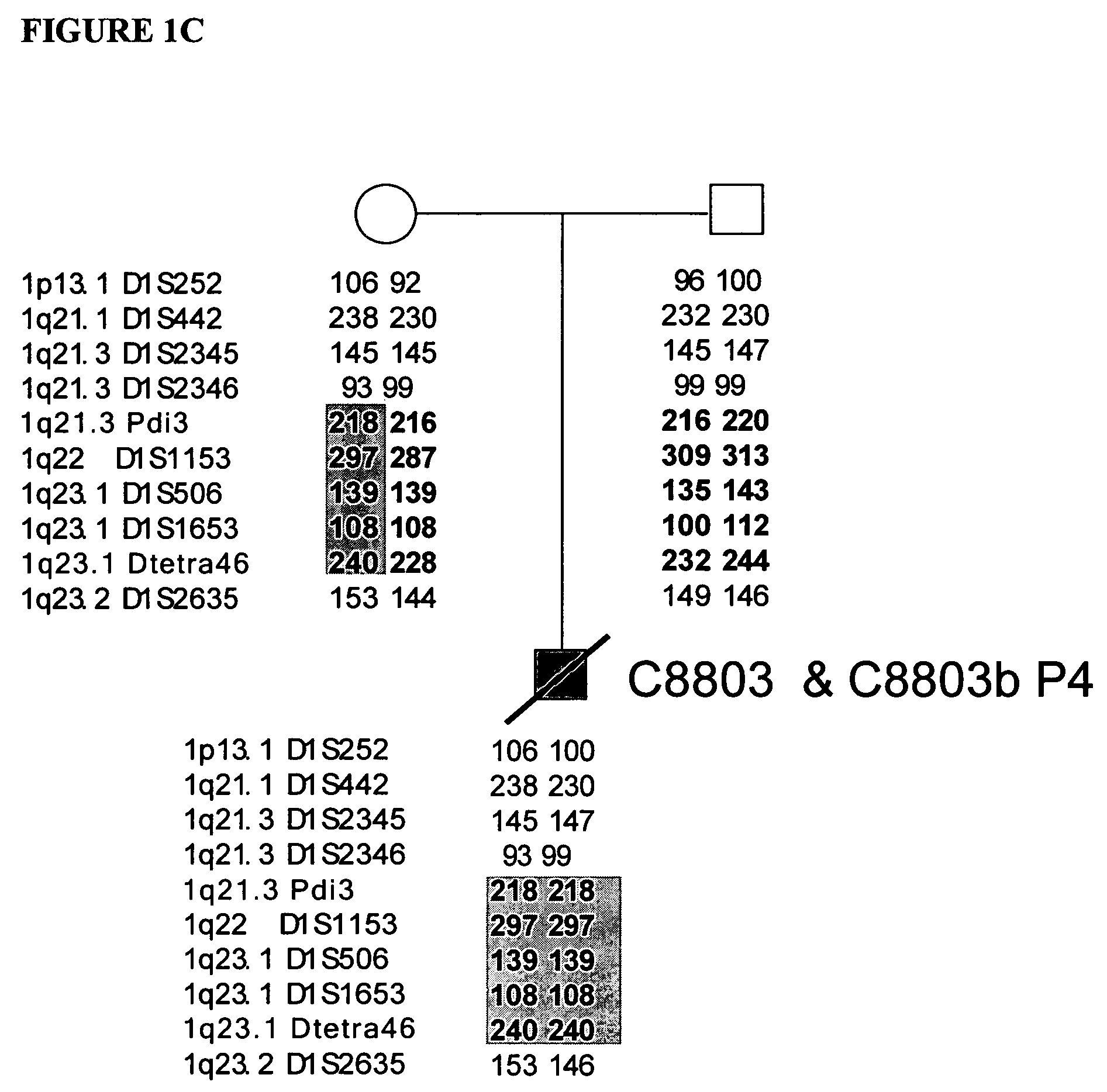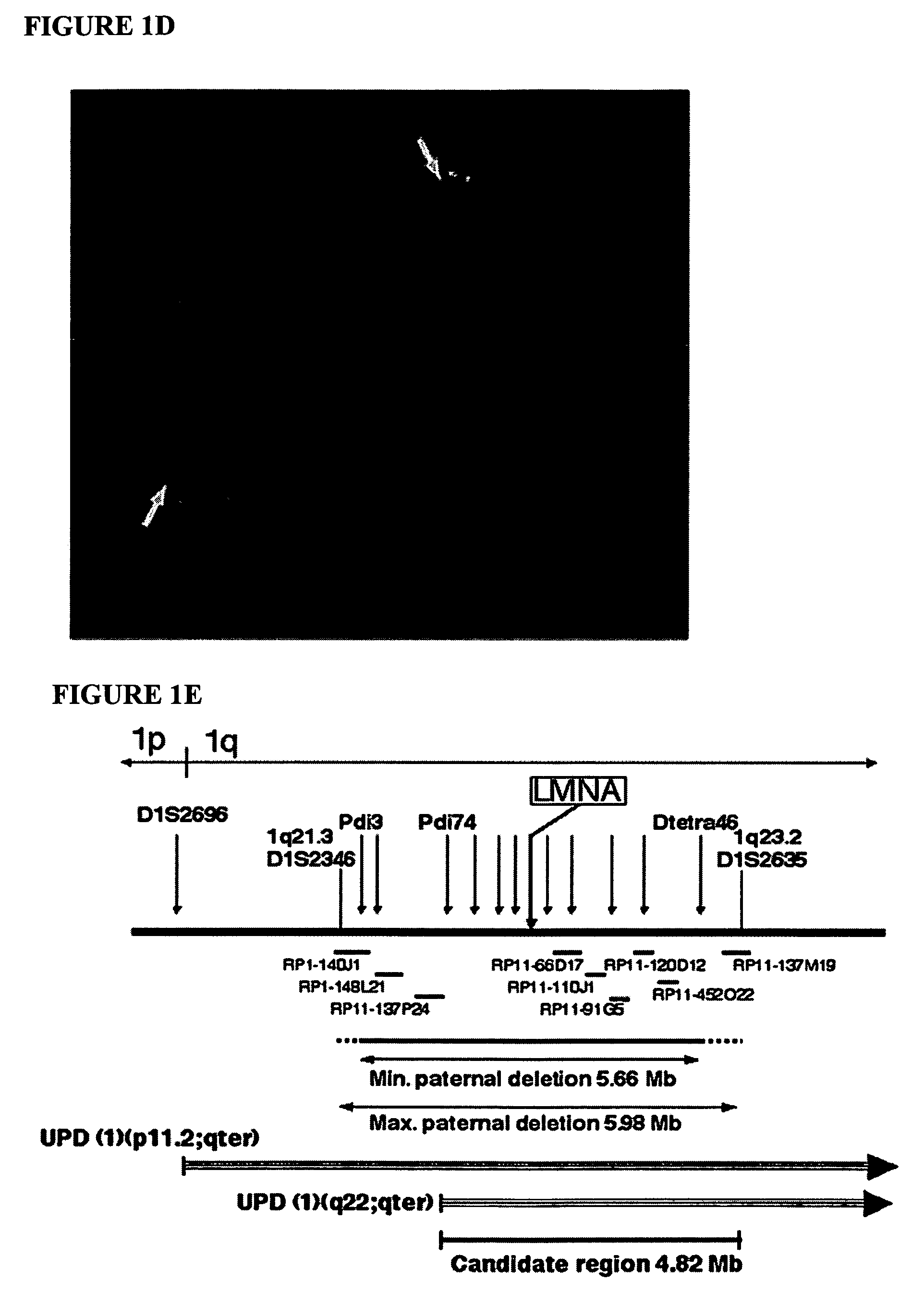LMNA gene and its involvement in Hutchinson-Gilford Progeria Syndrome (HGPS) and arteriosclerosis
a technology of lmna and progeria, applied in the field of gene lmna, can solve the problems of life-threatening complications, hair loss, eyebrow and eyelash sparseness, and unusually prominent veins of the scalp
- Summary
- Abstract
- Description
- Claims
- Application Information
AI Technical Summary
Benefits of technology
Problems solved by technology
Method used
Image
Examples
example 1
Identification of LMNA as Implicated in HGPS
[0116]This example provides evidence of rare sequence variants in LMNA that are linked to and causative for Hutchinson-Gilford Progeria Syndrome (HGPS, OMIM #176670), based on molecular genetic analysis of patients with this disorder.
[0117]HGPS is an extremely rare progeroid syndrome. Death occurs on average at age 16, usually from cardiovascular disease. The inheritance pattern of HGPS is not known. The presence of very few reported affected sibpairs and a modest paternal age effect, together with very few cases of known consanguinity, has led some to favor a sporadic dominant mechanism. However, a previous report of a consanguineous family with four affected siblings favored autosomal recessive inheritance.
[0118]This example demonstrates that de novo mutations in lamin A are the cause of this disorder. Initially the HGPS gene was localized to chromosome 1q by observing two cases of uniparental isodisomy of 1q, and one case with a six meg...
example 2
Other LMNA Polymorphisms and / or Mutations
[0153]With the provision herein of the correlation between LANA gene variants and HGPS, the isolation and identification of additional LMNA variants, including variants that lead to progeroid syndromes, is enabled and motivated. Any conventional method for the identification of genetic polymorphisms in a population can be used to identify such additional polymorphisms.
[0154]For instance, selective breeding studies in animals are performed to isolate different variants of LAMNA. Alternatively, existing populations (e.g., mouse or human populations) are assessed for progeria and / or age-related or premature aging conditions, and individuals within the population (particularly those with symptoms of progeria or other premature aging conditions) are genotyped as relates to an LMNA sequence. These LMNA sequences are then compared to a reference LMNA sequence, such as the normal allele shown herein, to determine the presence of one or more variant n...
example 3
Clinical Uses of LMNA Variants
[0157]To perform a diagnostic test for the presence or absence of a polymorphism or mutation in an LMNA sequence of an individual, a suitable genomic DNA-containing sample from a subject is obtained and the DNA extracted using conventional techniques. For instance in some embodiments a blood sample, a buccal swab, a hair follicle preparation, or a nasal aspirate is used as a source of cells to provide the DNA sample. The extracted DNA is then subjected to amplification, for example according to standard procedures. The allele of the single base-pair polymorphism is determined by conventional methods including manual and automated fluorescent DNA sequencing, primer extension methods (Nikiforov, et al., Nucl Acids Res. 22:4167-4175, 1994), oligonucleotide ligation assay (OLA) (Nickerson et al., Proc. Natl. Acad Sci. USA 87:8923-8927, 1990), allele-specific PCR methods (Rust et al., Nucl. Acids Res. 6:3623-3629, 1993), RNase mismatch cleavage, single stran...
PUM
| Property | Measurement | Unit |
|---|---|---|
| concentration | aaaaa | aaaaa |
| weight | aaaaa | aaaaa |
| joint stiffness | aaaaa | aaaaa |
Abstract
Description
Claims
Application Information
 Login to View More
Login to View More - R&D
- Intellectual Property
- Life Sciences
- Materials
- Tech Scout
- Unparalleled Data Quality
- Higher Quality Content
- 60% Fewer Hallucinations
Browse by: Latest US Patents, China's latest patents, Technical Efficacy Thesaurus, Application Domain, Technology Topic, Popular Technical Reports.
© 2025 PatSnap. All rights reserved.Legal|Privacy policy|Modern Slavery Act Transparency Statement|Sitemap|About US| Contact US: help@patsnap.com



